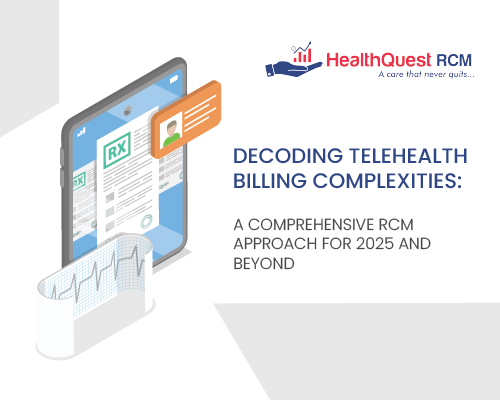Telehealth adoption has surged, but its billing complexities continue to challenge healthcare providers. From evolving reimbursement policies to coding inconsistencies, navigating telehealth billing requires a proactive approach to revenue cycle management. In 2025 and beyond, healthcare organizations must optimize their billing strategies to maximize reimbursement and minimize claim denials.
Latest CMS Telehealth Reimbursement Updates and Their Impact on Provider Revenue
The Centers for Medicare & Medicaid Services (CMS) has introduced new telehealth reimbursement policies that significantly impact provider revenue. Key updates include:
- Expanded Covered Services: Additional telehealth procedures now qualify for reimbursement.
- Changes in Place-of-Service Codes: Providers must use the correct codes to ensure full payment.
- Telehealth Parity Policies: Some payers offer equal reimbursement for virtual and in-person visits, but others impose restrictions.
- State-Specific Regulations: Cross-state licensure requirements continue to evolve, affecting reimbursement eligibility.
Understanding these changes is crucial for maximizing telemedicine reimbursement and ensuring financial stability.
Overcoming Billing Challenges Unique to Virtual Patient Encounters
Telehealth billing presents unique challenges, including:
- Modifier Misusage: Incorrect modifiers can result in claim denials or underpayments.
- Documentation Gaps: Incomplete records make it difficult to justify telehealth services.
- Payer-Specific Policies: Insurers have varying rules for reimbursing virtual visits.
- Cross-State Licensing Issues: Providers must comply with regulations in both patient and provider locations.
By implementing robust revenue cycle management (RCM) strategies, healthcare organizations can overcome these hurdles and streamline telehealth billing processes.
Revenue Growth Tactics: Maximizing Telehealth Profitability Through Strategic Coding and Documentation
Accurate coding and thorough documentation are essential for optimizing telehealth revenue. Strategies include:
- Use of Correct CPT and HCPCS Codes: Ensure all telehealth services are coded accurately for full reimbursement.
- Detailed Visit Documentation: Include start and end times, provider-patient interactions, and medical necessity details.
- Billing for Remote Patient Monitoring (RPM): Expanding telehealth services to include RPM increases revenue opportunities.
- Ensuring Compliance with Payer Guidelines: Stay updated on insurer-specific requirements to avoid claim denials.
Essential Tools for Streamlining Telehealth Billing Processes to Avoid Claim Denials
Leveraging technology is key to avoiding claim denials and improving reimbursement rates. Essential tools include:
- AI-Powered Claim Scrubbing Software: Identifies errors before submission.
- Automated Eligibility Verification Systems: Confirms patient insurance coverage in real time.
- Integrated EHR and Billing Platforms: Streamlines documentation and billing workflows.
- Real-Time Analytics Dashboards: Provides insights into revenue cycle performance and payer trends.
Emerging Telehealth Billing Best Practices from Leading Healthcare Providers in 2025
Industry leaders are adopting new best practices to enhance telehealth billing efficiency:
- Proactive Payer Contract Negotiation: Securing better reimbursement rates for virtual care.
- Regular Staff Training on Telehealth Billing Updates: Keeping billing teams informed about evolving regulations.
- Data-Driven Decision-Making: Using predictive analytics to identify trends and optimize billing strategies.
- Multi-State Credentialing Programs: Simplifying cross-state licensing for expanded patient reach.
Conclusion
Telehealth billing complexities require a strategic and technology-driven approach. By staying updated on CMS regulations, optimizing documentation, leveraging automation, and implementing best practices, healthcare providers can enhance revenue cycle management and maximize reimbursements in 2025 and beyond.
FAQ Section
The most common challenges include incorrect coding, documentation gaps, payer-specific reimbursement rules, and cross-state licensing complexities.
Providers can optimize reimbursements by using accurate CPT/HCPCS codes, ensuring complete documentation, negotiating payer contracts, and leveraging AI-powered billing tools.
Automation helps reduce errors, speed up claims processing, verify patient eligibility in real time, and improve overall revenue cycle management efficiency.
Negotiating contracts with payers ensures that providers receive competitive reimbursement rates for telehealth services, reducing revenue loss.
Using AI-driven claim scrubbing, staying updated on payer policies, implementing real-time eligibility verification, and conducting regular audits can minimize denials.

